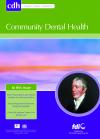Community Dental Health

- Cover Date:
- March 2007
- Print ISSN:
- 0265 539X
- Vol:
- 24
- Issue:
- 1
BASCD Survey report
The dental caries experience of 5-year-old children in Great Britain (2005/6). Surveys co-ordinated by the British Association for the Study of Community Dentistry.
Objective This paper reports the results of standardized clinical caries examinations of 5-year-old children from across England, Wales and Scotland in 2005/6. These co-ordinated surveys are the latest in a series which seek to monitor the dental health of children and to assess the delivery of dental services. Method The criteria and conventions of the British Association for the Study of Community Dentistry were used. Representative samples were drawn from participating strategic health authorities (SHAs), primary care trusts (PCTs) and health boards (HBs). Caries was diagnosed at the caries into dentine threshold using a visual method without radiography or ï¬bre-optic transillumination. Results 239,389 ï¬ve and six year-old children from across England, Wales, Scotland and the Isle of Man were examined in 2005/2006. The results again demonstrated a wide variation in disease prevalence and care strategies across Great Britain. Mean d3mft across England was 1.47 (d3t=1.l0, mt=0.20, ft=0.16), across Wales the corresponding values were 2.38 (d3t=1.70, mt=0.43, ft=0.25) and in Scotland 2.16 (d3t=1.45, mt=0.51, ft=0.20). Overall, 39.4% of children in Great Britain had evidence of caries experience in dentine (d3mft>0, including visual dentine caries). The distribution of caries was highly skewed. Thus the mean caries experience for those with dentinal decay was 3.99, as opposed to the overall mean of 1.57. Trends over time demonstrate a small change in mean d3mft since 2003/4 when the mean was 1.62, although the mean value for those with dentine decay experience remained constant (4.00 vs 3.99). The care index has also fallen marginally from 12% to 11%. The BASCD co-ordinated NHS Epidemiology Programme will evolve in coming years as differing priorities in the frequency of inspecting particular age groups is being seen as well as a desire to measure other aspects of oral health in addition. Conclusion Overall, there has been only a small overall improvement in the dental health of 5-year-old children over the last 2 years and no diminution of the level of disease in those affected for some time, although in Scotland a pattern of continuing steady progress from previously high levels is seen. While many children enjoy good oral health, sizable groups remain within the population of 5-year-old children who have a clinically signiï¬cant burden of preventable dental disease. Key words: caries prevalence, dental caries, dental epidemiology, national surveys, oral health
Introduction
This paper sets out the results of the most recent series of surveys of 5-year-old children conducted within the National Health Services (NHS) under the auspices of the British Association for the Study of Community Dentistry (BASCD) Dental Epidemiology Programme during 2005-6. This includes data collected in Scotland by the NHS Boards under the National Dental Inspection Programme. The Programme seeks to link together the various (and increasingly diverse) dental epidemiology activities carried out locally and nationally in order to monitor the dental health of children using as comparable criteria and methodology as is possible given current logistics and priorities. The Programme contributes to the national monitoring of service provision and targets in a devolved United Kingdom, while also providing data locally to aid in service planning and evaluation of Oral Health Strategies and Plans. There has been a phase of continuing change within the NHS organisations across Great Britain, leading to
a continuing need to overcome a number of signiï¬cant logistical challenges in covering and reporting results according to moving boundaries and service conï¬gurations.
Method
The agreed BASCD criteria (Pitts et al., 1997) and conventions set out in the BASCD trainer’s pack (Mitropoulos et al., 1992) were employed. Within Wales and within each English ‘region’, a designated NHS epidemiology coordinator was responsible for the local delivery of the Programme, assisted by a ‘regional’ trainer who attends the biennial national training and calibration exercise. In Scotland the National Dental Inspection Programme inspects children in Primary 1 classes. It is managed by the NHS boards (National Dental Inspection Programme, 2007) and a central training and calibration exercise is conducted annually in Perth. Representative samples were drawn from participating health authorities and boards according to the agreed BASCD guidelines (Pine et al., 1997). Dental caries
Correspondence to: Professor N B Pitts, Dental Health Services Research Unit, Mackenzie Building, Kirsty Semple Way, Dundee DD2 4BF. E-mail: n.b.pitts@dundee.ac.uk
- Article Price
- £15.00
- Institution Article Price
- £
- Page Start
- 59
- Page End
- 63
- Authors
- N.B. Pitts, J. Boyles, Z.J. Nugent, N. Thomas, C.M. Pine
Articles from this issue
- Title
- Pg. Start
- Pg. End
- Editorial - Expanding dental undergraduate clinical outreach programmes into general dental practice.
- 2
- 3
- Agreement amongst examiners assessing dental fluorosis from digital photographs using the TF index.
- 21
- 25
- Enamel defects and its relation to life course events in primary dentition of Brazilian children: A longitudinal study
- 31
- 36
- Knowledge of and attitudes toward severe acute respiratory syndrome among a cohort of dental patients in Hong Kong following a major local outbreak
- 43
- 48
- An audit of paediatric dental treatments carried out under general anaesthesia in a sample of Spanish patients
- 55
- 58
